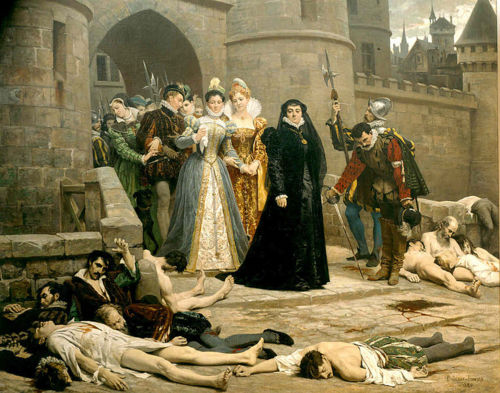Robard Plasquet and St. Bartholomew’s Day massacre
Robard Plasquet – 1568 – 1634 (11x Grt Grandfather, and founding father of all the South of England Plaskett’s)
The St. Bartholomew’s Day massacre (Massacre de la Saint-Barthélemy in French) in 1572 was a targeted group of assassinations, followed by a wave of Roman Catholic mob violence, both directed against the Huguenots (French Calvinist Protestants), during the French Wars of Religion. Traditionally believed to have been instigated by Catherine de’ Medici, the mother of King Charles IX, the massacre took place four days after the wedding of the king’s sister Margaret to the Protestant Henry III of Navarre (the future Henry IV of France). This marriage was an occasion for which many of the most wealthy and prominent Huguenots had gathered in largely Catholic Paris.
The massacre began on 23 August 1572 (the eve of the feast of Bartholomew the Apostle), two days after the attempted assassination of Admiral Gaspard de Coligny, the military and political leader of the Huguenots. The king ordered the killing of a group of Huguenot leaders, including Coligny, and the slaughter spread throughout Paris. Lasting several weeks, the massacre expanded outward to other urban centers and the countryside. Modern estimates for the number of dead vary widely, from 5,000 to 30,000.

In 1572 Robard Plasquet (Robert Plaskett in English) would have been a mere 4 yrs old. It is unclear if Robard was born here in England or in France, what is clear, is that currently no English baptism has been located for him or his three siblings. So in all probability Robard Plasquet was French by birth alongside his siblings and parents.
If this is true, then the family was still living in France when the St. Bartholomew’s Day Massacre occurred on the 23 August 1572.
Shortly after this dreadful day French Huguenot refugees began to flood into the country. An estimated 50,000 Protestant Walloons and Huguenots fled to England, about 10,000 of whom moved on to Ireland around the 1690s. In relative terms, this was one of the largest waves of immigration ever of a single ethnic community into Britain. Andrew Lortie (born André Lortie), a leading Huguenot theologian and writer who led the exiled community in London, became known for articulating their criticism of the Pope and the doctrine of transubstantiation during the Mass.
Of the refugees who arrived on the Kent coast, many gravitated towards Canterbury, then the county’s Calvinist hub. Many Walloon and Huguenot families were granted asylum there. Edward VI granted them the whole of the western crypt of Canterbury Cathedral for worship. This privilege in 1825 was reduced to the south aisle and in 1895 to the former chantry chapel of the Black Prince. Services are still held there in French according to the Reformed tradition every Sunday at 3 pm.
Other evidence of the Walloons and Huguenots in Canterbury includes a block of houses in Turnagain Lane, where weavers’ windows survive on the top floor, as many Huguenots worked as weavers. The Weavers, a half-timbered house by the river, was the site of a weaving school from the late 16th century to about 1830. (It has been adapted as a restaurant. The house derives its name from a weaving school which was moved there in the last years of the 19th century, reviving an earlier use.) Others refugees practiced the variety of occupations necessary to sustain the community as distinct from the indigenous population. Such economic separation was the condition of the refugees’ initial acceptance in the City. They also settled elsewhere in Kent, particularly Sandwich, Faversham and Maidstone—towns in which there used to be refugee churches.
The French Protestant Church of London was established by Royal Charter in 1550. It is now located at Soho Square. Huguenot refugees flocked to Shoreditch, London. They established a major weaving industry in and around Spitalfields in East London. In Wandsworth, their gardening skills benefited the Battersea market gardens. The Old Truman Brewery, then known as the Black Eagle Brewery, was founded in 1724. The flight of Huguenot refugees from Tours, France drew off most of the workers of its great silk mills which they had built.
Other Huguenots arriving in England settled in Bedfordshire, which was at the time the main center of England’s lace industry. Huguenots greatly contributed to the development of lace-making in Bedfordshire, with many families settling in Cranfield, Bedford and Luton. Some of these immigrants moved to Norwich, which had accommodated an earlier settlement of Walloon weavers. The French added to the existing immigrant population, then comprising about a third of the population of the city.
It is commonly believed that our Plaskett ancestors arrived in Southampton, Hampshire in the late 16th century where an established Walloon and Huguenot church existed. They later moved across Hampshire and into Wiltshire and London.
Robard Plasquet’s father is recorded as being married in Charke, Titchfield, Hampshire in 1575… This was probably his second marriage, no evidence currently exists for his first marriage (probably in France), but we know a previous marriage existed because Robard was born in 1568. Robard had three siblings: Cooke, Jone and Thamer Plaskett, these may have been half siblings, through his father’s second marriage?!?
What happened to Robard Plasquet’s Mother?
We can only guess: perhaps she died during the St. Bartholomew’s massacre, and because of this the remaining family fled with their lives.

Sadly no name is recorded in the English Archives for Robard’s father, mother or step mother… Robard’s step mother on the other hand was simply known as: ‘WIDOW PLASKETT’, after the death of her husband in Titchfield, Hampshire, England in 1591.
After 1602, the family relocated to Downton, Wiltshire, England and began to adopt a more English way of life including using an English variation of their name… ‘ROBERT PLASKETT’, as he was now known became the forefather of all the South of England’s Plaskett descendants.
He was married twice, both of whom were probably English Women, his first wife was Alles Brokes and they married on the 16th February 1589 in Titchfield, Hampshire, England. What became of Alles is not known but she must have died young either through child birth (which was common) or perhaps even plague which was rearing its ugly head on and off throughout the 16th century.
His second wife we know simply as ‘EDITH’, no surname for her has been recorded?!?
They married on the 6th April 1602 in Titchfield, Hampshire, England.
Robert and Edith Plaskett are known to have had two children Frauncys ‘Francis’ Plaskett who was baptised on the 23 July 1603 in Church of St. Lawrence, Downton, Wiltshire, England and Roger Plaskett who was baptized on the 16th February 1606 also in the Church of St. Lawrence, Downton, Wiltshire, England.
Frauncys ‘Francis’ Plaskett is my 10x Grt Grandfather and he went on to marry Christabell Bowne in 1629 and they had 8 known children. It is not known if Roger had any children or if he was ever married.
Robert Plaskett’s stepmother Widow Plaskett died in April 1608 and was buried on the 20 April 1608 aged 53 yrs in the Church of St. Lawrence, Downton, Wiltshire, England.
Robert Plaskett lived until he was 66 years old, and was buried on the 15 October 1634, his wife Edith died four years later and was buried on the 19th October 1638, they both now rest together in the Church of St. Lawrence, Downton, Wiltshire, England.
My research into these incredible people continues, what they must have gone through during this turbulent time in our history is unimaginable. Watching your loved ones die on the streets of Paris, and on the streets of many other French cities and towns on that fateful day 23 August 1572 – the day that went down in history and became known as the St. Bartholomew’s Day massacre
It’s a story and a piece of history that intrigues me, and it’s their story and it’s a story we may truly never know the harsh realities off. The only understanding off it is to look at the history of that day, and the events that would have shaped their lives, and the lives of their descendants forever.
Bill Alderson, aka Bull Plaskett as coined by his Uncle Cyril Plaskett is the son of Marianne Plaskett, Mabel and Ed Plaskett's youngest daughter. Bill spent much of his childhood around Pacific Valley with his grandparents. At 13, Bill donned a backpack alone and hiked the hills his grandfather mentioned to see it on his own. That still hasn't changed as Bill continues to experience the Coast and works to build this site for his family, particularly his 4 grandchildren he hopes will come to love the area and the memory of his large extended Plaskett Family.

Recent Comments